Health Policy Briefing on Obesity in Australia
VerifiedAdded on 2023/06/04
|13
|3816
|469
AI Summary
This policy briefing discusses the prevalence, causes, impacts, and policy implications of obesity in Australia. It recommends developing policies that would help in reducing the prevalence of the disorder and thereby, reducing the burden of the disease on the healthcare system and the economy as a whole.
Contribute Materials
Your contribution can guide someone’s learning journey. Share your
documents today.
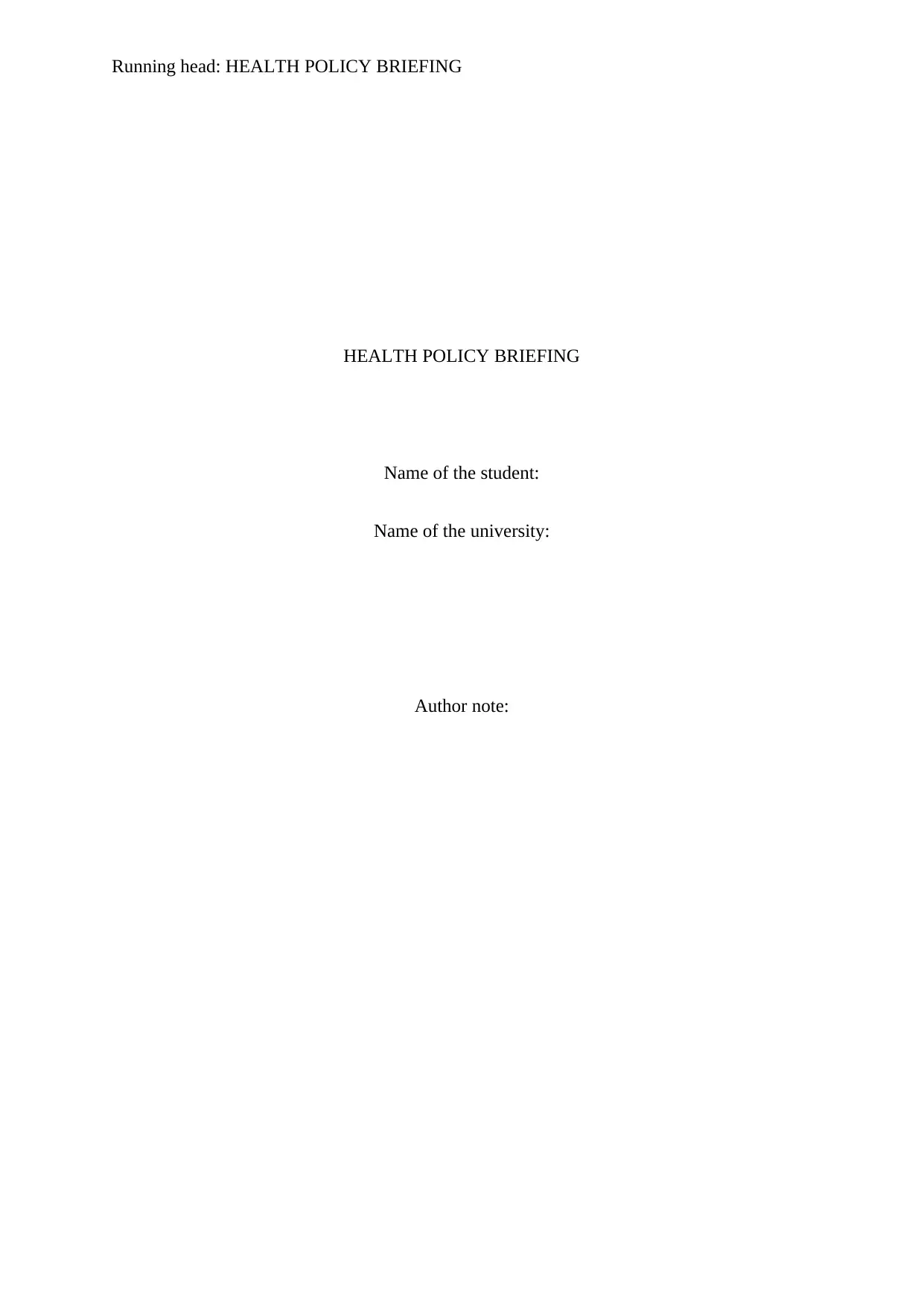
Running head: HEALTH POLICY BRIEFING
HEALTH POLICY BRIEFING
Name of the student:
Name of the university:
Author note:
HEALTH POLICY BRIEFING
Name of the student:
Name of the university:
Author note:
Secure Best Marks with AI Grader
Need help grading? Try our AI Grader for instant feedback on your assignments.
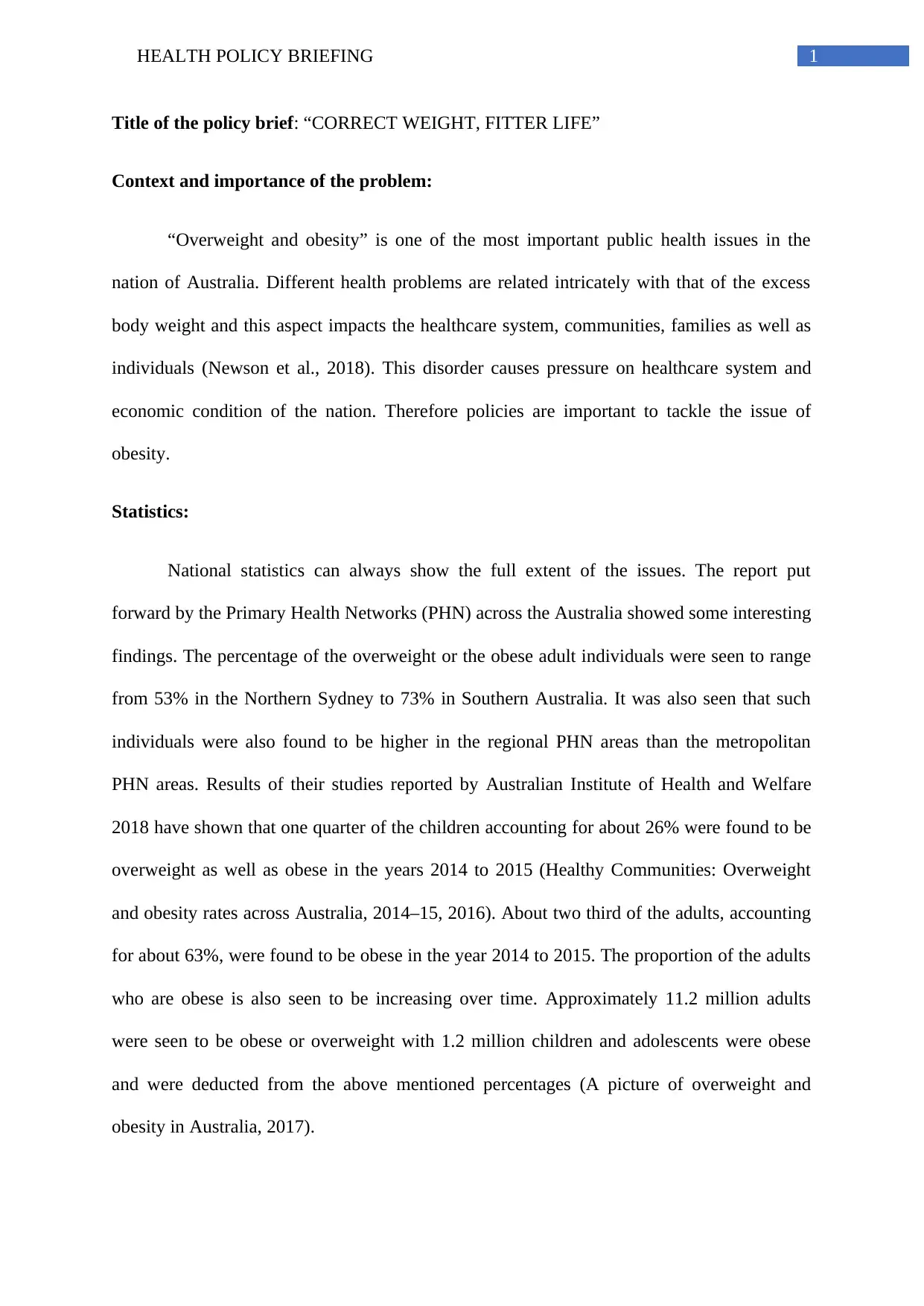
1HEALTH POLICY BRIEFING
Title of the policy brief: “CORRECT WEIGHT, FITTER LIFE”
Context and importance of the problem:
“Overweight and obesity” is one of the most important public health issues in the
nation of Australia. Different health problems are related intricately with that of the excess
body weight and this aspect impacts the healthcare system, communities, families as well as
individuals (Newson et al., 2018). This disorder causes pressure on healthcare system and
economic condition of the nation. Therefore policies are important to tackle the issue of
obesity.
Statistics:
National statistics can always show the full extent of the issues. The report put
forward by the Primary Health Networks (PHN) across the Australia showed some interesting
findings. The percentage of the overweight or the obese adult individuals were seen to range
from 53% in the Northern Sydney to 73% in Southern Australia. It was also seen that such
individuals were also found to be higher in the regional PHN areas than the metropolitan
PHN areas. Results of their studies reported by Australian Institute of Health and Welfare
2018 have shown that one quarter of the children accounting for about 26% were found to be
overweight as well as obese in the years 2014 to 2015 (Healthy Communities: Overweight
and obesity rates across Australia, 2014–15, 2016). About two third of the adults, accounting
for about 63%, were found to be obese in the year 2014 to 2015. The proportion of the adults
who are obese is also seen to be increasing over time. Approximately 11.2 million adults
were seen to be obese or overweight with 1.2 million children and adolescents were obese
and were deducted from the above mentioned percentages (A picture of overweight and
obesity in Australia, 2017).
Title of the policy brief: “CORRECT WEIGHT, FITTER LIFE”
Context and importance of the problem:
“Overweight and obesity” is one of the most important public health issues in the
nation of Australia. Different health problems are related intricately with that of the excess
body weight and this aspect impacts the healthcare system, communities, families as well as
individuals (Newson et al., 2018). This disorder causes pressure on healthcare system and
economic condition of the nation. Therefore policies are important to tackle the issue of
obesity.
Statistics:
National statistics can always show the full extent of the issues. The report put
forward by the Primary Health Networks (PHN) across the Australia showed some interesting
findings. The percentage of the overweight or the obese adult individuals were seen to range
from 53% in the Northern Sydney to 73% in Southern Australia. It was also seen that such
individuals were also found to be higher in the regional PHN areas than the metropolitan
PHN areas. Results of their studies reported by Australian Institute of Health and Welfare
2018 have shown that one quarter of the children accounting for about 26% were found to be
overweight as well as obese in the years 2014 to 2015 (Healthy Communities: Overweight
and obesity rates across Australia, 2014–15, 2016). About two third of the adults, accounting
for about 63%, were found to be obese in the year 2014 to 2015. The proportion of the adults
who are obese is also seen to be increasing over time. Approximately 11.2 million adults
were seen to be obese or overweight with 1.2 million children and adolescents were obese
and were deducted from the above mentioned percentages (A picture of overweight and
obesity in Australia, 2017).
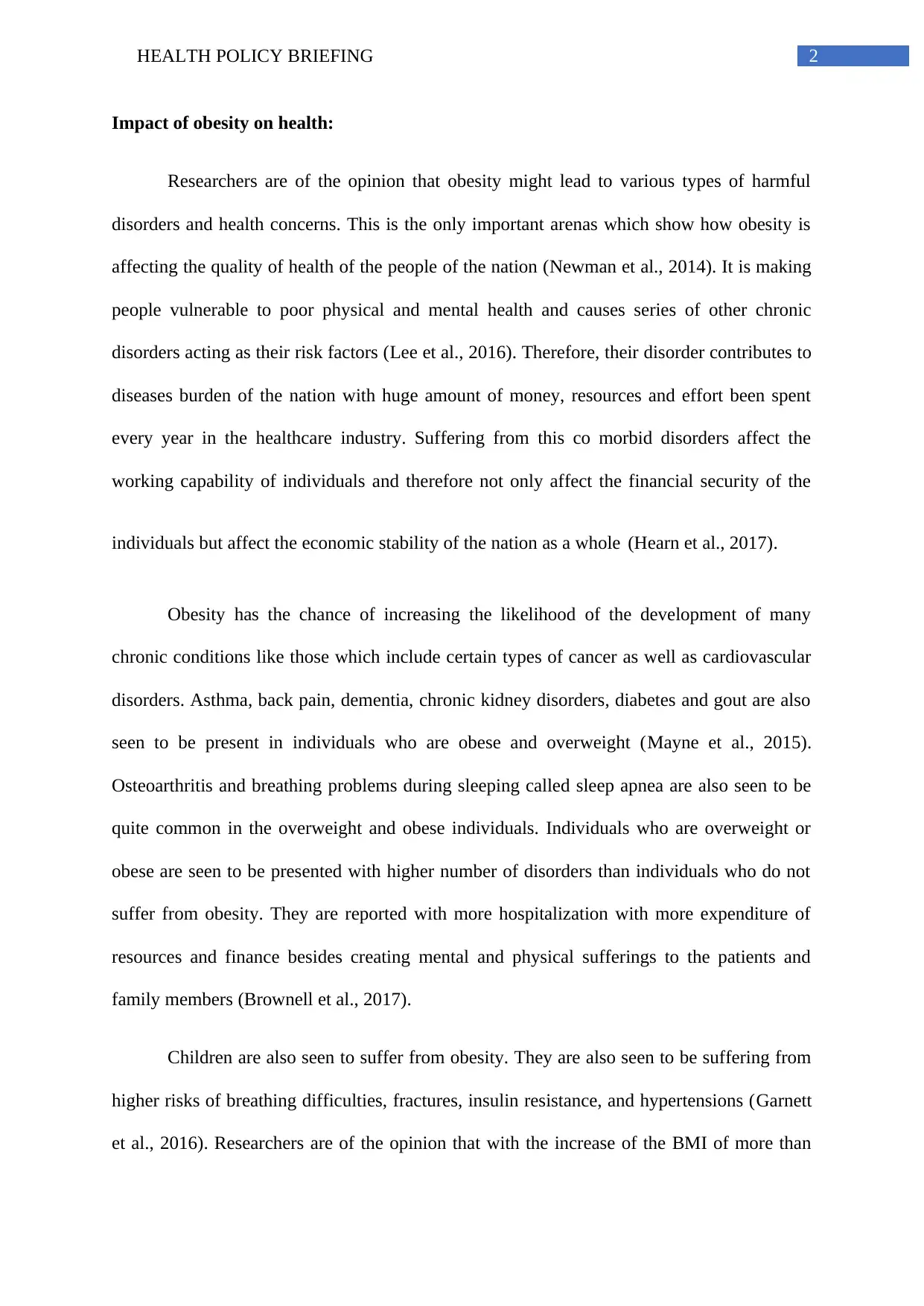
2HEALTH POLICY BRIEFING
Impact of obesity on health:
Researchers are of the opinion that obesity might lead to various types of harmful
disorders and health concerns. This is the only important arenas which show how obesity is
affecting the quality of health of the people of the nation (Newman et al., 2014). It is making
people vulnerable to poor physical and mental health and causes series of other chronic
disorders acting as their risk factors (Lee et al., 2016). Therefore, their disorder contributes to
diseases burden of the nation with huge amount of money, resources and effort been spent
every year in the healthcare industry. Suffering from this co morbid disorders affect the
working capability of individuals and therefore not only affect the financial security of the
individuals but affect the economic stability of the nation as a whole (Hearn et al., 2017).
Obesity has the chance of increasing the likelihood of the development of many
chronic conditions like those which include certain types of cancer as well as cardiovascular
disorders. Asthma, back pain, dementia, chronic kidney disorders, diabetes and gout are also
seen to be present in individuals who are obese and overweight (Mayne et al., 2015).
Osteoarthritis and breathing problems during sleeping called sleep apnea are also seen to be
quite common in the overweight and obese individuals. Individuals who are overweight or
obese are seen to be presented with higher number of disorders than individuals who do not
suffer from obesity. They are reported with more hospitalization with more expenditure of
resources and finance besides creating mental and physical sufferings to the patients and
family members (Brownell et al., 2017).
Children are also seen to suffer from obesity. They are also seen to be suffering from
higher risks of breathing difficulties, fractures, insulin resistance, and hypertensions (Garnett
et al., 2016). Researchers are of the opinion that with the increase of the BMI of more than
Impact of obesity on health:
Researchers are of the opinion that obesity might lead to various types of harmful
disorders and health concerns. This is the only important arenas which show how obesity is
affecting the quality of health of the people of the nation (Newman et al., 2014). It is making
people vulnerable to poor physical and mental health and causes series of other chronic
disorders acting as their risk factors (Lee et al., 2016). Therefore, their disorder contributes to
diseases burden of the nation with huge amount of money, resources and effort been spent
every year in the healthcare industry. Suffering from this co morbid disorders affect the
working capability of individuals and therefore not only affect the financial security of the
individuals but affect the economic stability of the nation as a whole (Hearn et al., 2017).
Obesity has the chance of increasing the likelihood of the development of many
chronic conditions like those which include certain types of cancer as well as cardiovascular
disorders. Asthma, back pain, dementia, chronic kidney disorders, diabetes and gout are also
seen to be present in individuals who are obese and overweight (Mayne et al., 2015).
Osteoarthritis and breathing problems during sleeping called sleep apnea are also seen to be
quite common in the overweight and obese individuals. Individuals who are overweight or
obese are seen to be presented with higher number of disorders than individuals who do not
suffer from obesity. They are reported with more hospitalization with more expenditure of
resources and finance besides creating mental and physical sufferings to the patients and
family members (Brownell et al., 2017).
Children are also seen to suffer from obesity. They are also seen to be suffering from
higher risks of breathing difficulties, fractures, insulin resistance, and hypertensions (Garnett
et al., 2016). Researchers are of the opinion that with the increase of the BMI of more than
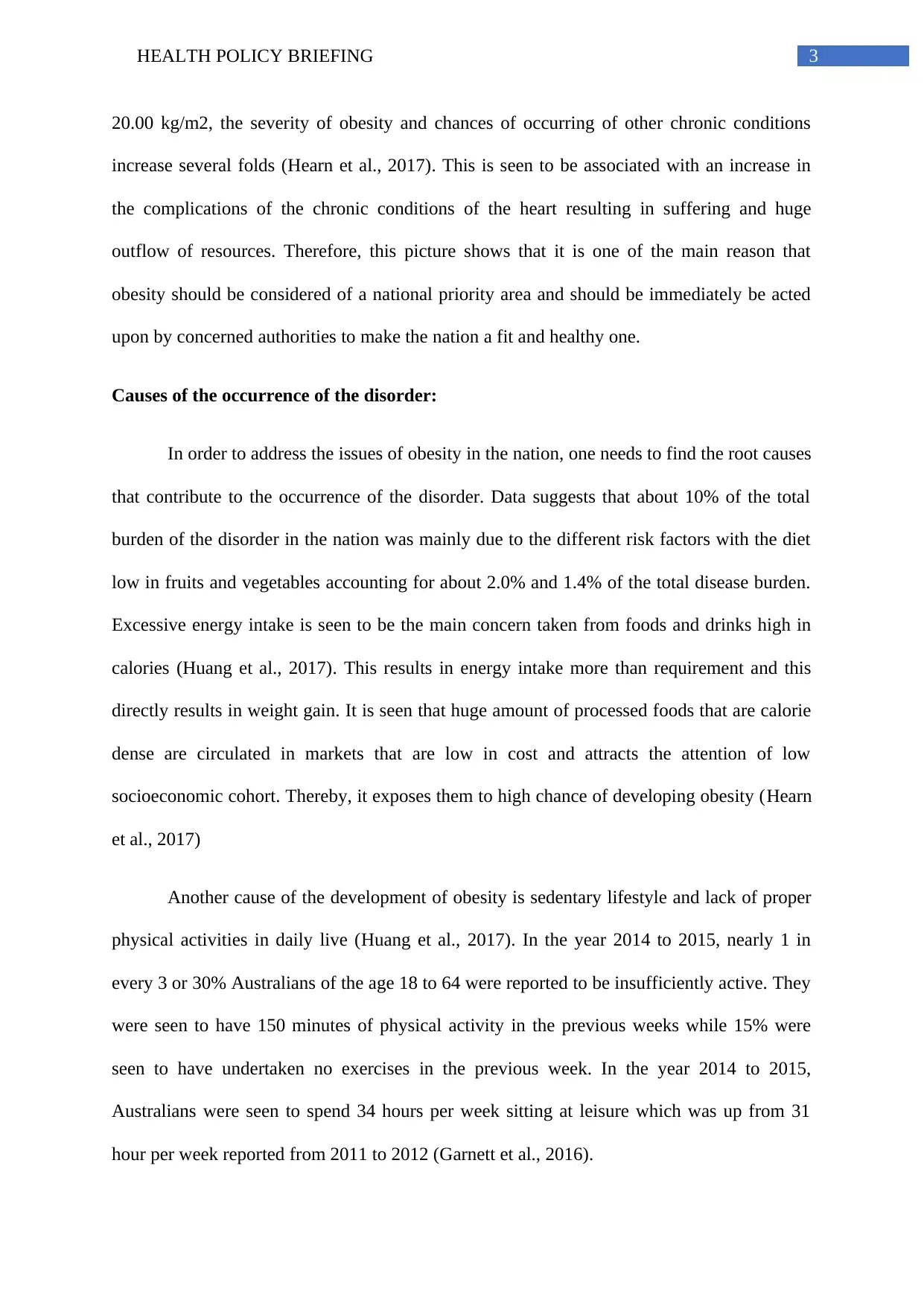
3HEALTH POLICY BRIEFING
20.00 kg/m2, the severity of obesity and chances of occurring of other chronic conditions
increase several folds (Hearn et al., 2017). This is seen to be associated with an increase in
the complications of the chronic conditions of the heart resulting in suffering and huge
outflow of resources. Therefore, this picture shows that it is one of the main reason that
obesity should be considered of a national priority area and should be immediately be acted
upon by concerned authorities to make the nation a fit and healthy one.
Causes of the occurrence of the disorder:
In order to address the issues of obesity in the nation, one needs to find the root causes
that contribute to the occurrence of the disorder. Data suggests that about 10% of the total
burden of the disorder in the nation was mainly due to the different risk factors with the diet
low in fruits and vegetables accounting for about 2.0% and 1.4% of the total disease burden.
Excessive energy intake is seen to be the main concern taken from foods and drinks high in
calories (Huang et al., 2017). This results in energy intake more than requirement and this
directly results in weight gain. It is seen that huge amount of processed foods that are calorie
dense are circulated in markets that are low in cost and attracts the attention of low
socioeconomic cohort. Thereby, it exposes them to high chance of developing obesity (Hearn
et al., 2017)
Another cause of the development of obesity is sedentary lifestyle and lack of proper
physical activities in daily live (Huang et al., 2017). In the year 2014 to 2015, nearly 1 in
every 3 or 30% Australians of the age 18 to 64 were reported to be insufficiently active. They
were seen to have 150 minutes of physical activity in the previous weeks while 15% were
seen to have undertaken no exercises in the previous week. In the year 2014 to 2015,
Australians were seen to spend 34 hours per week sitting at leisure which was up from 31
hour per week reported from 2011 to 2012 (Garnett et al., 2016).
20.00 kg/m2, the severity of obesity and chances of occurring of other chronic conditions
increase several folds (Hearn et al., 2017). This is seen to be associated with an increase in
the complications of the chronic conditions of the heart resulting in suffering and huge
outflow of resources. Therefore, this picture shows that it is one of the main reason that
obesity should be considered of a national priority area and should be immediately be acted
upon by concerned authorities to make the nation a fit and healthy one.
Causes of the occurrence of the disorder:
In order to address the issues of obesity in the nation, one needs to find the root causes
that contribute to the occurrence of the disorder. Data suggests that about 10% of the total
burden of the disorder in the nation was mainly due to the different risk factors with the diet
low in fruits and vegetables accounting for about 2.0% and 1.4% of the total disease burden.
Excessive energy intake is seen to be the main concern taken from foods and drinks high in
calories (Huang et al., 2017). This results in energy intake more than requirement and this
directly results in weight gain. It is seen that huge amount of processed foods that are calorie
dense are circulated in markets that are low in cost and attracts the attention of low
socioeconomic cohort. Thereby, it exposes them to high chance of developing obesity (Hearn
et al., 2017)
Another cause of the development of obesity is sedentary lifestyle and lack of proper
physical activities in daily live (Huang et al., 2017). In the year 2014 to 2015, nearly 1 in
every 3 or 30% Australians of the age 18 to 64 were reported to be insufficiently active. They
were seen to have 150 minutes of physical activity in the previous weeks while 15% were
seen to have undertaken no exercises in the previous week. In the year 2014 to 2015,
Australians were seen to spend 34 hours per week sitting at leisure which was up from 31
hour per week reported from 2011 to 2012 (Garnett et al., 2016).
Secure Best Marks with AI Grader
Need help grading? Try our AI Grader for instant feedback on your assignments.
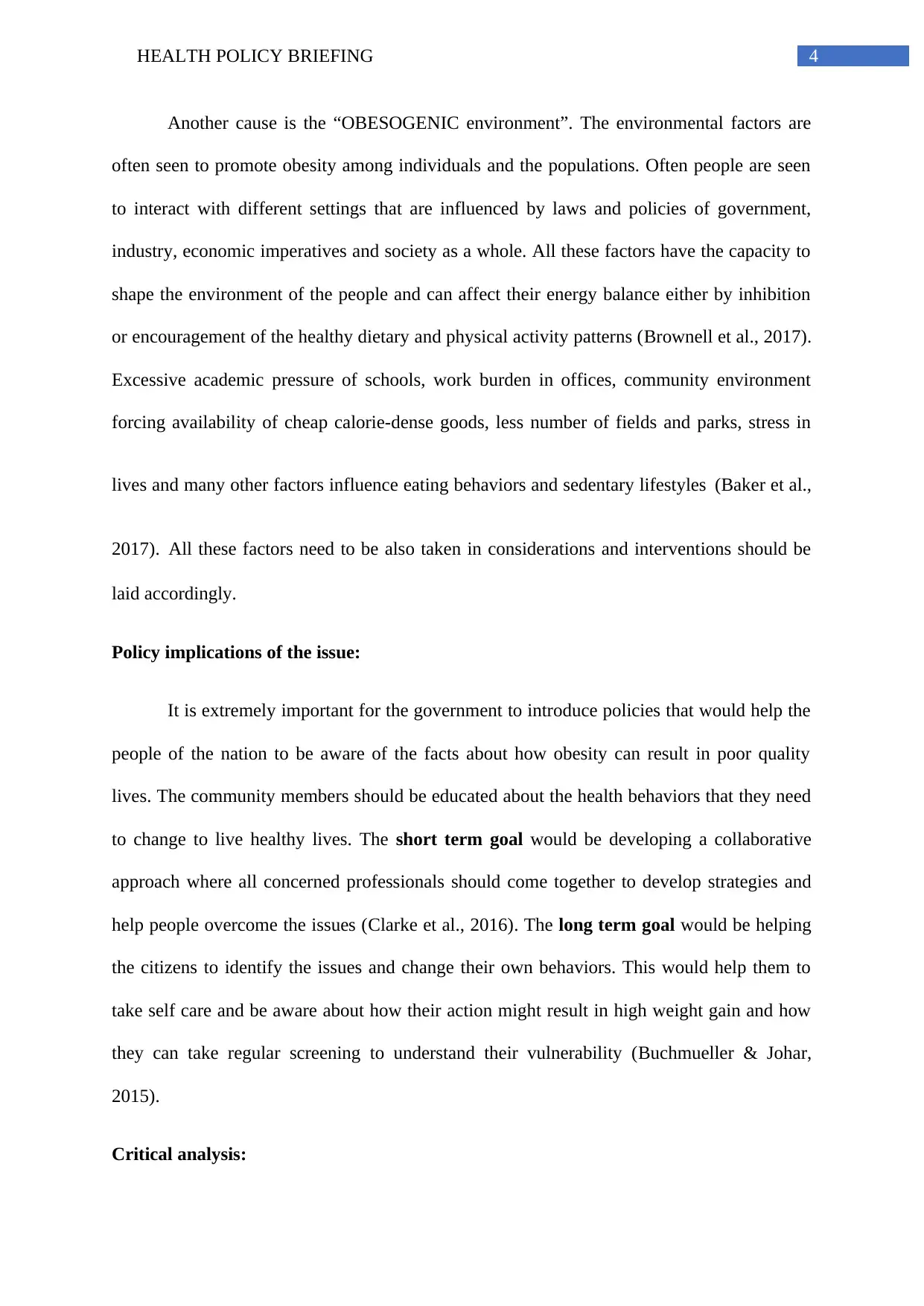
4HEALTH POLICY BRIEFING
Another cause is the “OBESOGENIC environment”. The environmental factors are
often seen to promote obesity among individuals and the populations. Often people are seen
to interact with different settings that are influenced by laws and policies of government,
industry, economic imperatives and society as a whole. All these factors have the capacity to
shape the environment of the people and can affect their energy balance either by inhibition
or encouragement of the healthy dietary and physical activity patterns (Brownell et al., 2017).
Excessive academic pressure of schools, work burden in offices, community environment
forcing availability of cheap calorie-dense goods, less number of fields and parks, stress in
lives and many other factors influence eating behaviors and sedentary lifestyles (Baker et al.,
2017). All these factors need to be also taken in considerations and interventions should be
laid accordingly.
Policy implications of the issue:
It is extremely important for the government to introduce policies that would help the
people of the nation to be aware of the facts about how obesity can result in poor quality
lives. The community members should be educated about the health behaviors that they need
to change to live healthy lives. The short term goal would be developing a collaborative
approach where all concerned professionals should come together to develop strategies and
help people overcome the issues (Clarke et al., 2016). The long term goal would be helping
the citizens to identify the issues and change their own behaviors. This would help them to
take self care and be aware about how their action might result in high weight gain and how
they can take regular screening to understand their vulnerability (Buchmueller & Johar,
2015).
Critical analysis:
Another cause is the “OBESOGENIC environment”. The environmental factors are
often seen to promote obesity among individuals and the populations. Often people are seen
to interact with different settings that are influenced by laws and policies of government,
industry, economic imperatives and society as a whole. All these factors have the capacity to
shape the environment of the people and can affect their energy balance either by inhibition
or encouragement of the healthy dietary and physical activity patterns (Brownell et al., 2017).
Excessive academic pressure of schools, work burden in offices, community environment
forcing availability of cheap calorie-dense goods, less number of fields and parks, stress in
lives and many other factors influence eating behaviors and sedentary lifestyles (Baker et al.,
2017). All these factors need to be also taken in considerations and interventions should be
laid accordingly.
Policy implications of the issue:
It is extremely important for the government to introduce policies that would help the
people of the nation to be aware of the facts about how obesity can result in poor quality
lives. The community members should be educated about the health behaviors that they need
to change to live healthy lives. The short term goal would be developing a collaborative
approach where all concerned professionals should come together to develop strategies and
help people overcome the issues (Clarke et al., 2016). The long term goal would be helping
the citizens to identify the issues and change their own behaviors. This would help them to
take self care and be aware about how their action might result in high weight gain and how
they can take regular screening to understand their vulnerability (Buchmueller & Johar,
2015).
Critical analysis:
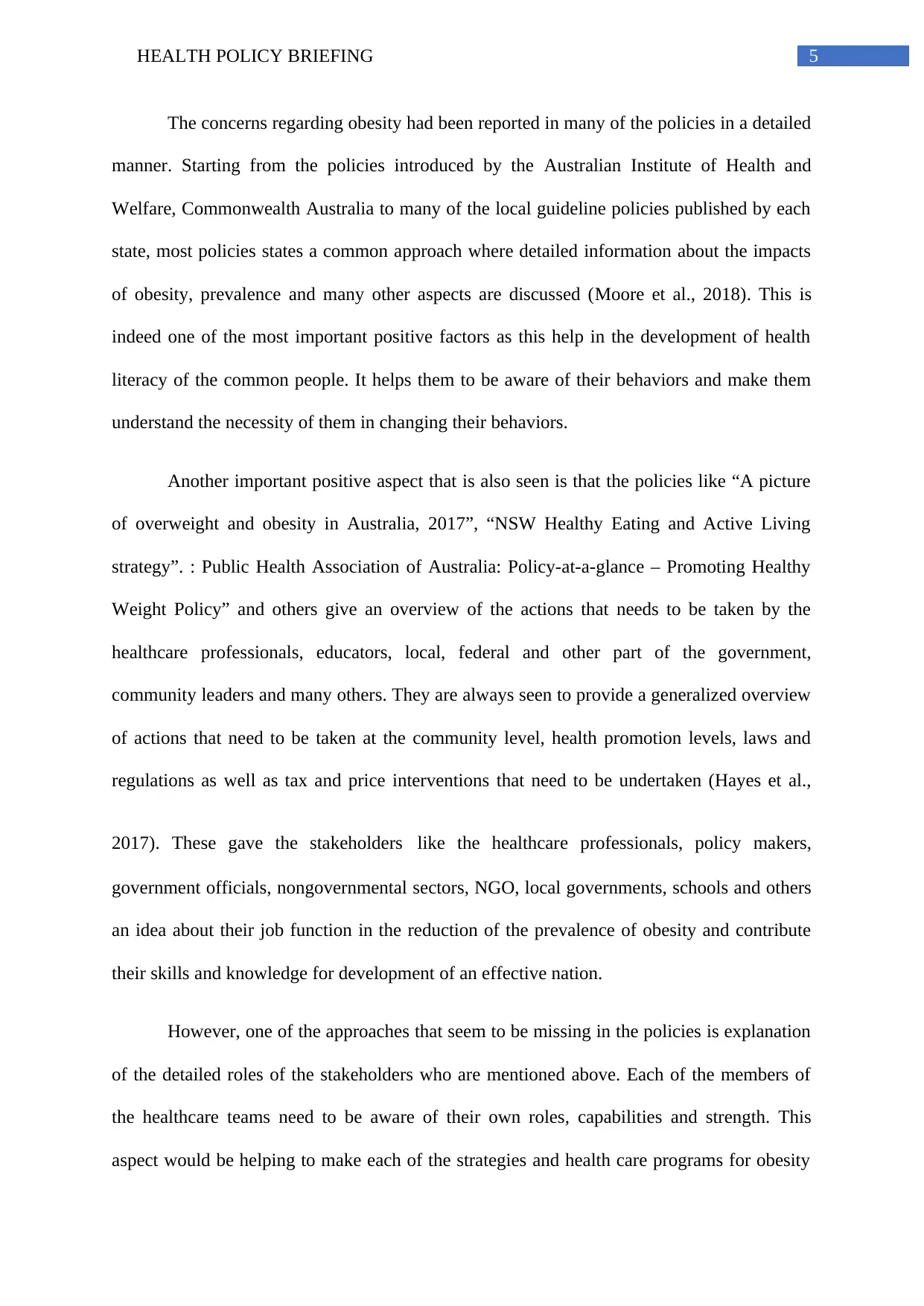
5HEALTH POLICY BRIEFING
The concerns regarding obesity had been reported in many of the policies in a detailed
manner. Starting from the policies introduced by the Australian Institute of Health and
Welfare, Commonwealth Australia to many of the local guideline policies published by each
state, most policies states a common approach where detailed information about the impacts
of obesity, prevalence and many other aspects are discussed (Moore et al., 2018). This is
indeed one of the most important positive factors as this help in the development of health
literacy of the common people. It helps them to be aware of their behaviors and make them
understand the necessity of them in changing their behaviors.
Another important positive aspect that is also seen is that the policies like “A picture
of overweight and obesity in Australia, 2017”, “NSW Healthy Eating and Active Living
strategy”. : Public Health Association of Australia: Policy-at-a-glance – Promoting Healthy
Weight Policy” and others give an overview of the actions that needs to be taken by the
healthcare professionals, educators, local, federal and other part of the government,
community leaders and many others. They are always seen to provide a generalized overview
of actions that need to be taken at the community level, health promotion levels, laws and
regulations as well as tax and price interventions that need to be undertaken (Hayes et al.,
2017). These gave the stakeholders like the healthcare professionals, policy makers,
government officials, nongovernmental sectors, NGO, local governments, schools and others
an idea about their job function in the reduction of the prevalence of obesity and contribute
their skills and knowledge for development of an effective nation.
However, one of the approaches that seem to be missing in the policies is explanation
of the detailed roles of the stakeholders who are mentioned above. Each of the members of
the healthcare teams need to be aware of their own roles, capabilities and strength. This
aspect would be helping to make each of the strategies and health care programs for obesity
The concerns regarding obesity had been reported in many of the policies in a detailed
manner. Starting from the policies introduced by the Australian Institute of Health and
Welfare, Commonwealth Australia to many of the local guideline policies published by each
state, most policies states a common approach where detailed information about the impacts
of obesity, prevalence and many other aspects are discussed (Moore et al., 2018). This is
indeed one of the most important positive factors as this help in the development of health
literacy of the common people. It helps them to be aware of their behaviors and make them
understand the necessity of them in changing their behaviors.
Another important positive aspect that is also seen is that the policies like “A picture
of overweight and obesity in Australia, 2017”, “NSW Healthy Eating and Active Living
strategy”. : Public Health Association of Australia: Policy-at-a-glance – Promoting Healthy
Weight Policy” and others give an overview of the actions that needs to be taken by the
healthcare professionals, educators, local, federal and other part of the government,
community leaders and many others. They are always seen to provide a generalized overview
of actions that need to be taken at the community level, health promotion levels, laws and
regulations as well as tax and price interventions that need to be undertaken (Hayes et al.,
2017). These gave the stakeholders like the healthcare professionals, policy makers,
government officials, nongovernmental sectors, NGO, local governments, schools and others
an idea about their job function in the reduction of the prevalence of obesity and contribute
their skills and knowledge for development of an effective nation.
However, one of the approaches that seem to be missing in the policies is explanation
of the detailed roles of the stakeholders who are mentioned above. Each of the members of
the healthcare teams need to be aware of their own roles, capabilities and strength. This
aspect would be helping to make each of the strategies and health care programs for obesity
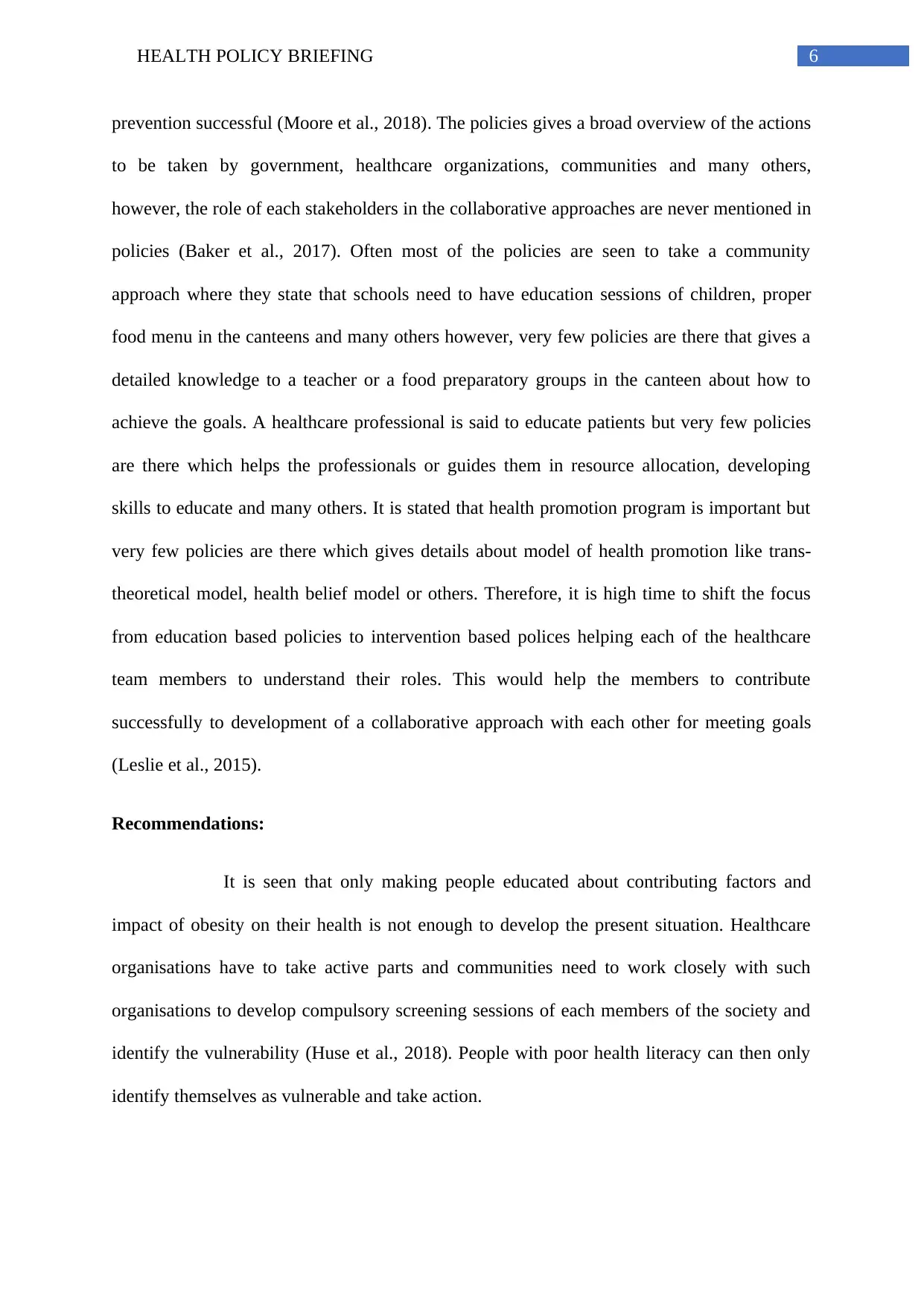
6HEALTH POLICY BRIEFING
prevention successful (Moore et al., 2018). The policies gives a broad overview of the actions
to be taken by government, healthcare organizations, communities and many others,
however, the role of each stakeholders in the collaborative approaches are never mentioned in
policies (Baker et al., 2017). Often most of the policies are seen to take a community
approach where they state that schools need to have education sessions of children, proper
food menu in the canteens and many others however, very few policies are there that gives a
detailed knowledge to a teacher or a food preparatory groups in the canteen about how to
achieve the goals. A healthcare professional is said to educate patients but very few policies
are there which helps the professionals or guides them in resource allocation, developing
skills to educate and many others. It is stated that health promotion program is important but
very few policies are there which gives details about model of health promotion like trans-
theoretical model, health belief model or others. Therefore, it is high time to shift the focus
from education based policies to intervention based polices helping each of the healthcare
team members to understand their roles. This would help the members to contribute
successfully to development of a collaborative approach with each other for meeting goals
(Leslie et al., 2015).
Recommendations:
It is seen that only making people educated about contributing factors and
impact of obesity on their health is not enough to develop the present situation. Healthcare
organisations have to take active parts and communities need to work closely with such
organisations to develop compulsory screening sessions of each members of the society and
identify the vulnerability (Huse et al., 2018). People with poor health literacy can then only
identify themselves as vulnerable and take action.
prevention successful (Moore et al., 2018). The policies gives a broad overview of the actions
to be taken by government, healthcare organizations, communities and many others,
however, the role of each stakeholders in the collaborative approaches are never mentioned in
policies (Baker et al., 2017). Often most of the policies are seen to take a community
approach where they state that schools need to have education sessions of children, proper
food menu in the canteens and many others however, very few policies are there that gives a
detailed knowledge to a teacher or a food preparatory groups in the canteen about how to
achieve the goals. A healthcare professional is said to educate patients but very few policies
are there which helps the professionals or guides them in resource allocation, developing
skills to educate and many others. It is stated that health promotion program is important but
very few policies are there which gives details about model of health promotion like trans-
theoretical model, health belief model or others. Therefore, it is high time to shift the focus
from education based policies to intervention based polices helping each of the healthcare
team members to understand their roles. This would help the members to contribute
successfully to development of a collaborative approach with each other for meeting goals
(Leslie et al., 2015).
Recommendations:
It is seen that only making people educated about contributing factors and
impact of obesity on their health is not enough to develop the present situation. Healthcare
organisations have to take active parts and communities need to work closely with such
organisations to develop compulsory screening sessions of each members of the society and
identify the vulnerability (Huse et al., 2018). People with poor health literacy can then only
identify themselves as vulnerable and take action.
Paraphrase This Document
Need a fresh take? Get an instant paraphrase of this document with our AI Paraphraser
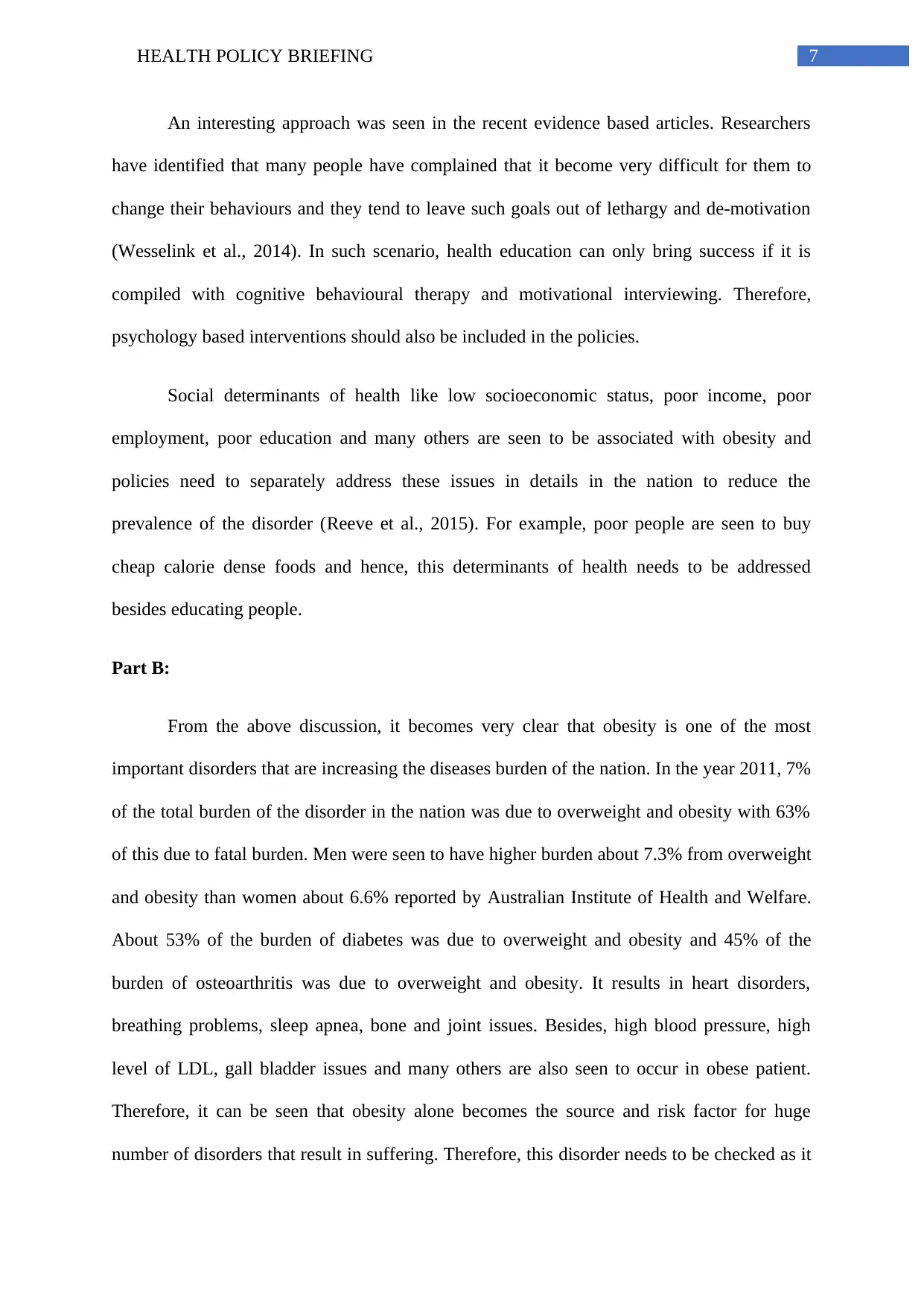
7HEALTH POLICY BRIEFING
An interesting approach was seen in the recent evidence based articles. Researchers
have identified that many people have complained that it become very difficult for them to
change their behaviours and they tend to leave such goals out of lethargy and de-motivation
(Wesselink et al., 2014). In such scenario, health education can only bring success if it is
compiled with cognitive behavioural therapy and motivational interviewing. Therefore,
psychology based interventions should also be included in the policies.
Social determinants of health like low socioeconomic status, poor income, poor
employment, poor education and many others are seen to be associated with obesity and
policies need to separately address these issues in details in the nation to reduce the
prevalence of the disorder (Reeve et al., 2015). For example, poor people are seen to buy
cheap calorie dense foods and hence, this determinants of health needs to be addressed
besides educating people.
Part B:
From the above discussion, it becomes very clear that obesity is one of the most
important disorders that are increasing the diseases burden of the nation. In the year 2011, 7%
of the total burden of the disorder in the nation was due to overweight and obesity with 63%
of this due to fatal burden. Men were seen to have higher burden about 7.3% from overweight
and obesity than women about 6.6% reported by Australian Institute of Health and Welfare.
About 53% of the burden of diabetes was due to overweight and obesity and 45% of the
burden of osteoarthritis was due to overweight and obesity. It results in heart disorders,
breathing problems, sleep apnea, bone and joint issues. Besides, high blood pressure, high
level of LDL, gall bladder issues and many others are also seen to occur in obese patient.
Therefore, it can be seen that obesity alone becomes the source and risk factor for huge
number of disorders that result in suffering. Therefore, this disorder needs to be checked as it
An interesting approach was seen in the recent evidence based articles. Researchers
have identified that many people have complained that it become very difficult for them to
change their behaviours and they tend to leave such goals out of lethargy and de-motivation
(Wesselink et al., 2014). In such scenario, health education can only bring success if it is
compiled with cognitive behavioural therapy and motivational interviewing. Therefore,
psychology based interventions should also be included in the policies.
Social determinants of health like low socioeconomic status, poor income, poor
employment, poor education and many others are seen to be associated with obesity and
policies need to separately address these issues in details in the nation to reduce the
prevalence of the disorder (Reeve et al., 2015). For example, poor people are seen to buy
cheap calorie dense foods and hence, this determinants of health needs to be addressed
besides educating people.
Part B:
From the above discussion, it becomes very clear that obesity is one of the most
important disorders that are increasing the diseases burden of the nation. In the year 2011, 7%
of the total burden of the disorder in the nation was due to overweight and obesity with 63%
of this due to fatal burden. Men were seen to have higher burden about 7.3% from overweight
and obesity than women about 6.6% reported by Australian Institute of Health and Welfare.
About 53% of the burden of diabetes was due to overweight and obesity and 45% of the
burden of osteoarthritis was due to overweight and obesity. It results in heart disorders,
breathing problems, sleep apnea, bone and joint issues. Besides, high blood pressure, high
level of LDL, gall bladder issues and many others are also seen to occur in obese patient.
Therefore, it can be seen that obesity alone becomes the source and risk factor for huge
number of disorders that result in suffering. Therefore, this disorder needs to be checked as it
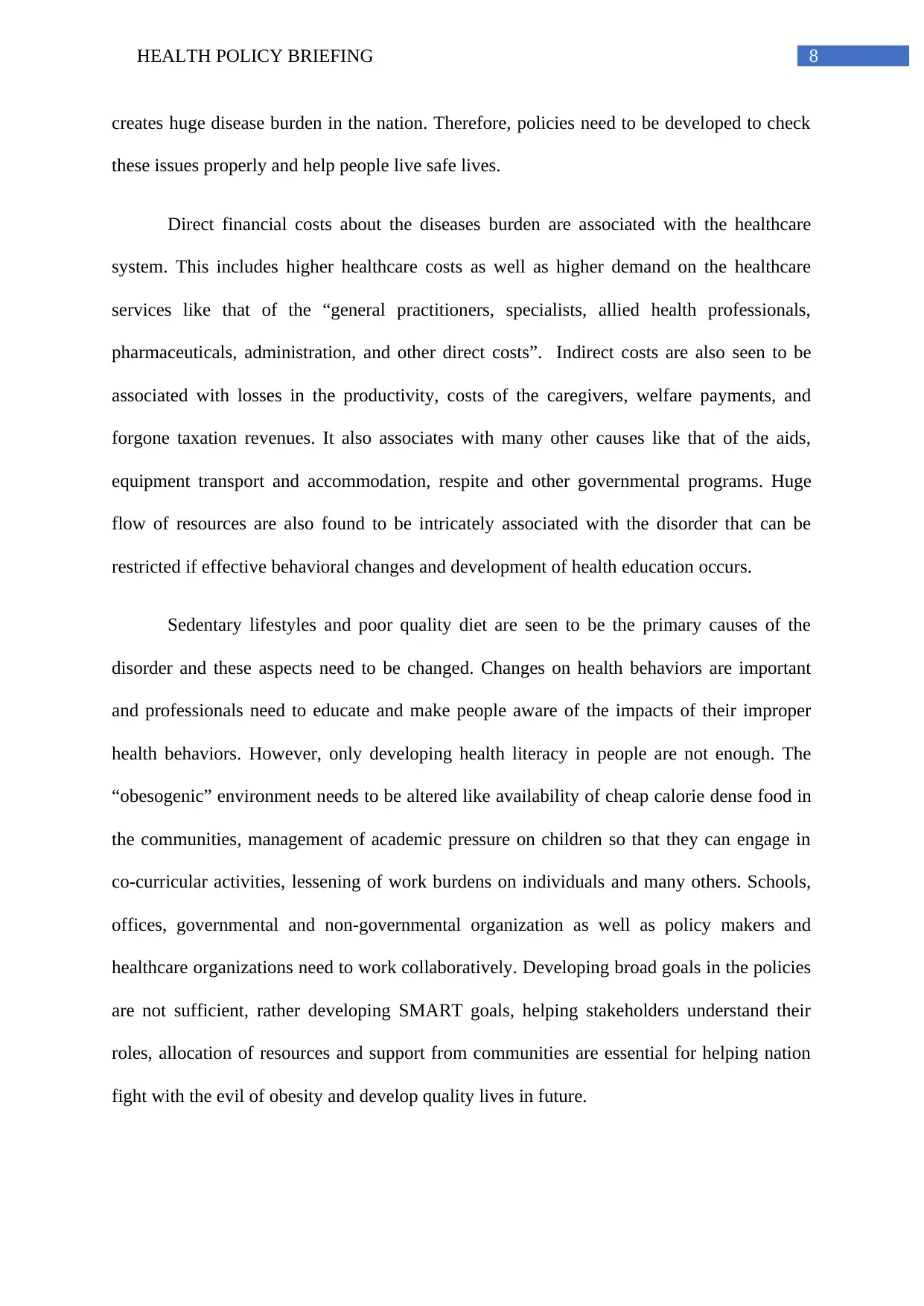
8HEALTH POLICY BRIEFING
creates huge disease burden in the nation. Therefore, policies need to be developed to check
these issues properly and help people live safe lives.
Direct financial costs about the diseases burden are associated with the healthcare
system. This includes higher healthcare costs as well as higher demand on the healthcare
services like that of the “general practitioners, specialists, allied health professionals,
pharmaceuticals, administration, and other direct costs”. Indirect costs are also seen to be
associated with losses in the productivity, costs of the caregivers, welfare payments, and
forgone taxation revenues. It also associates with many other causes like that of the aids,
equipment transport and accommodation, respite and other governmental programs. Huge
flow of resources are also found to be intricately associated with the disorder that can be
restricted if effective behavioral changes and development of health education occurs.
Sedentary lifestyles and poor quality diet are seen to be the primary causes of the
disorder and these aspects need to be changed. Changes on health behaviors are important
and professionals need to educate and make people aware of the impacts of their improper
health behaviors. However, only developing health literacy in people are not enough. The
“obesogenic” environment needs to be altered like availability of cheap calorie dense food in
the communities, management of academic pressure on children so that they can engage in
co-curricular activities, lessening of work burdens on individuals and many others. Schools,
offices, governmental and non-governmental organization as well as policy makers and
healthcare organizations need to work collaboratively. Developing broad goals in the policies
are not sufficient, rather developing SMART goals, helping stakeholders understand their
roles, allocation of resources and support from communities are essential for helping nation
fight with the evil of obesity and develop quality lives in future.
creates huge disease burden in the nation. Therefore, policies need to be developed to check
these issues properly and help people live safe lives.
Direct financial costs about the diseases burden are associated with the healthcare
system. This includes higher healthcare costs as well as higher demand on the healthcare
services like that of the “general practitioners, specialists, allied health professionals,
pharmaceuticals, administration, and other direct costs”. Indirect costs are also seen to be
associated with losses in the productivity, costs of the caregivers, welfare payments, and
forgone taxation revenues. It also associates with many other causes like that of the aids,
equipment transport and accommodation, respite and other governmental programs. Huge
flow of resources are also found to be intricately associated with the disorder that can be
restricted if effective behavioral changes and development of health education occurs.
Sedentary lifestyles and poor quality diet are seen to be the primary causes of the
disorder and these aspects need to be changed. Changes on health behaviors are important
and professionals need to educate and make people aware of the impacts of their improper
health behaviors. However, only developing health literacy in people are not enough. The
“obesogenic” environment needs to be altered like availability of cheap calorie dense food in
the communities, management of academic pressure on children so that they can engage in
co-curricular activities, lessening of work burdens on individuals and many others. Schools,
offices, governmental and non-governmental organization as well as policy makers and
healthcare organizations need to work collaboratively. Developing broad goals in the policies
are not sufficient, rather developing SMART goals, helping stakeholders understand their
roles, allocation of resources and support from communities are essential for helping nation
fight with the evil of obesity and develop quality lives in future.
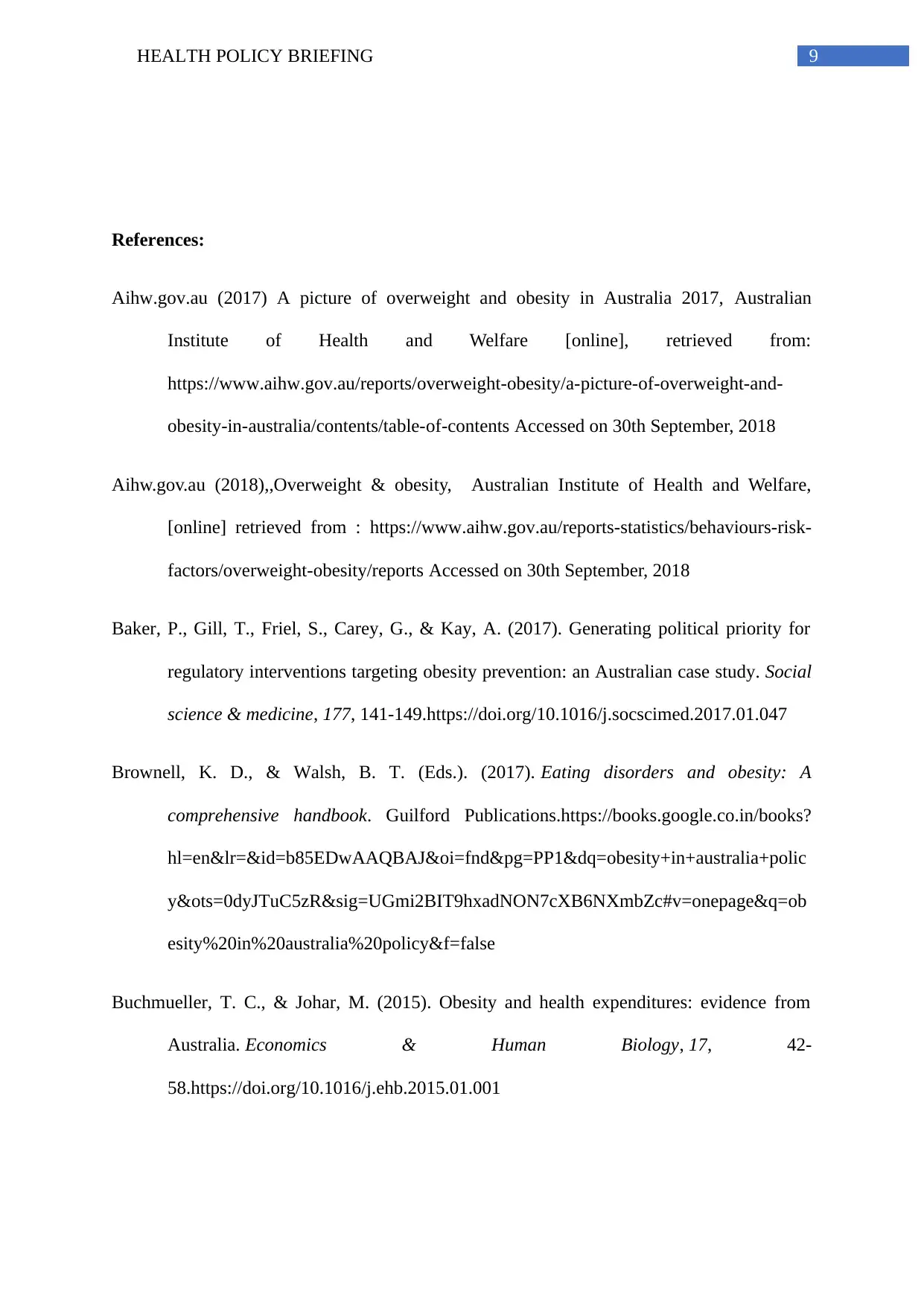
9HEALTH POLICY BRIEFING
References:
Aihw.gov.au (2017) A picture of overweight and obesity in Australia 2017, Australian
Institute of Health and Welfare [online], retrieved from:
https://www.aihw.gov.au/reports/overweight-obesity/a-picture-of-overweight-and-
obesity-in-australia/contents/table-of-contents Accessed on 30th September, 2018
Aihw.gov.au (2018),,Overweight & obesity, Australian Institute of Health and Welfare,
[online] retrieved from : https://www.aihw.gov.au/reports-statistics/behaviours-risk-
factors/overweight-obesity/reports Accessed on 30th September, 2018
Baker, P., Gill, T., Friel, S., Carey, G., & Kay, A. (2017). Generating political priority for
regulatory interventions targeting obesity prevention: an Australian case study. Social
science & medicine, 177, 141-149.https://doi.org/10.1016/j.socscimed.2017.01.047
Brownell, K. D., & Walsh, B. T. (Eds.). (2017). Eating disorders and obesity: A
comprehensive handbook. Guilford Publications.https://books.google.co.in/books?
hl=en&lr=&id=b85EDwAAQBAJ&oi=fnd&pg=PP1&dq=obesity+in+australia+polic
y&ots=0dyJTuC5zR&sig=UGmi2BIT9hxadNON7cXB6NXmbZc#v=onepage&q=ob
esity%20in%20australia%20policy&f=false
Buchmueller, T. C., & Johar, M. (2015). Obesity and health expenditures: evidence from
Australia. Economics & Human Biology, 17, 42-
58.https://doi.org/10.1016/j.ehb.2015.01.001
References:
Aihw.gov.au (2017) A picture of overweight and obesity in Australia 2017, Australian
Institute of Health and Welfare [online], retrieved from:
https://www.aihw.gov.au/reports/overweight-obesity/a-picture-of-overweight-and-
obesity-in-australia/contents/table-of-contents Accessed on 30th September, 2018
Aihw.gov.au (2018),,Overweight & obesity, Australian Institute of Health and Welfare,
[online] retrieved from : https://www.aihw.gov.au/reports-statistics/behaviours-risk-
factors/overweight-obesity/reports Accessed on 30th September, 2018
Baker, P., Gill, T., Friel, S., Carey, G., & Kay, A. (2017). Generating political priority for
regulatory interventions targeting obesity prevention: an Australian case study. Social
science & medicine, 177, 141-149.https://doi.org/10.1016/j.socscimed.2017.01.047
Brownell, K. D., & Walsh, B. T. (Eds.). (2017). Eating disorders and obesity: A
comprehensive handbook. Guilford Publications.https://books.google.co.in/books?
hl=en&lr=&id=b85EDwAAQBAJ&oi=fnd&pg=PP1&dq=obesity+in+australia+polic
y&ots=0dyJTuC5zR&sig=UGmi2BIT9hxadNON7cXB6NXmbZc#v=onepage&q=ob
esity%20in%20australia%20policy&f=false
Buchmueller, T. C., & Johar, M. (2015). Obesity and health expenditures: evidence from
Australia. Economics & Human Biology, 17, 42-
58.https://doi.org/10.1016/j.ehb.2015.01.001
Secure Best Marks with AI Grader
Need help grading? Try our AI Grader for instant feedback on your assignments.
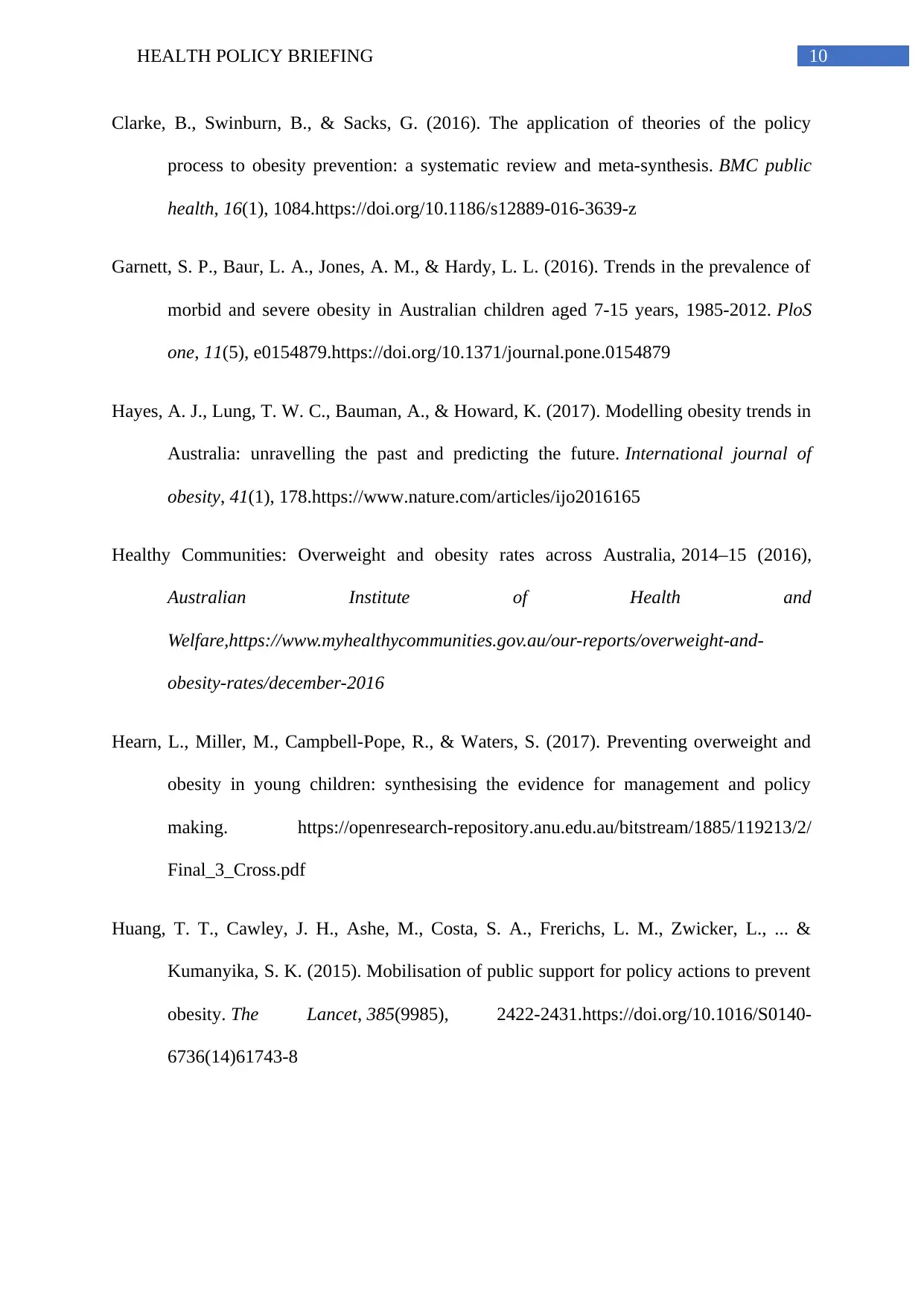
10HEALTH POLICY BRIEFING
Clarke, B., Swinburn, B., & Sacks, G. (2016). The application of theories of the policy
process to obesity prevention: a systematic review and meta-synthesis. BMC public
health, 16(1), 1084.https://doi.org/10.1186/s12889-016-3639-z
Garnett, S. P., Baur, L. A., Jones, A. M., & Hardy, L. L. (2016). Trends in the prevalence of
morbid and severe obesity in Australian children aged 7-15 years, 1985-2012. PloS
one, 11(5), e0154879.https://doi.org/10.1371/journal.pone.0154879
Hayes, A. J., Lung, T. W. C., Bauman, A., & Howard, K. (2017). Modelling obesity trends in
Australia: unravelling the past and predicting the future. International journal of
obesity, 41(1), 178.https://www.nature.com/articles/ijo2016165
Healthy Communities: Overweight and obesity rates across Australia, 2014–15 (2016),
Australian Institute of Health and
Welfare,https://www.myhealthycommunities.gov.au/our-reports/overweight-and-
obesity-rates/december-2016
Hearn, L., Miller, M., Campbell-Pope, R., & Waters, S. (2017). Preventing overweight and
obesity in young children: synthesising the evidence for management and policy
making. https://openresearch-repository.anu.edu.au/bitstream/1885/119213/2/
Final_3_Cross.pdf
Huang, T. T., Cawley, J. H., Ashe, M., Costa, S. A., Frerichs, L. M., Zwicker, L., ... &
Kumanyika, S. K. (2015). Mobilisation of public support for policy actions to prevent
obesity. The Lancet, 385(9985), 2422-2431.https://doi.org/10.1016/S0140-
6736(14)61743-8
Clarke, B., Swinburn, B., & Sacks, G. (2016). The application of theories of the policy
process to obesity prevention: a systematic review and meta-synthesis. BMC public
health, 16(1), 1084.https://doi.org/10.1186/s12889-016-3639-z
Garnett, S. P., Baur, L. A., Jones, A. M., & Hardy, L. L. (2016). Trends in the prevalence of
morbid and severe obesity in Australian children aged 7-15 years, 1985-2012. PloS
one, 11(5), e0154879.https://doi.org/10.1371/journal.pone.0154879
Hayes, A. J., Lung, T. W. C., Bauman, A., & Howard, K. (2017). Modelling obesity trends in
Australia: unravelling the past and predicting the future. International journal of
obesity, 41(1), 178.https://www.nature.com/articles/ijo2016165
Healthy Communities: Overweight and obesity rates across Australia, 2014–15 (2016),
Australian Institute of Health and
Welfare,https://www.myhealthycommunities.gov.au/our-reports/overweight-and-
obesity-rates/december-2016
Hearn, L., Miller, M., Campbell-Pope, R., & Waters, S. (2017). Preventing overweight and
obesity in young children: synthesising the evidence for management and policy
making. https://openresearch-repository.anu.edu.au/bitstream/1885/119213/2/
Final_3_Cross.pdf
Huang, T. T., Cawley, J. H., Ashe, M., Costa, S. A., Frerichs, L. M., Zwicker, L., ... &
Kumanyika, S. K. (2015). Mobilisation of public support for policy actions to prevent
obesity. The Lancet, 385(9985), 2422-2431.https://doi.org/10.1016/S0140-
6736(14)61743-8
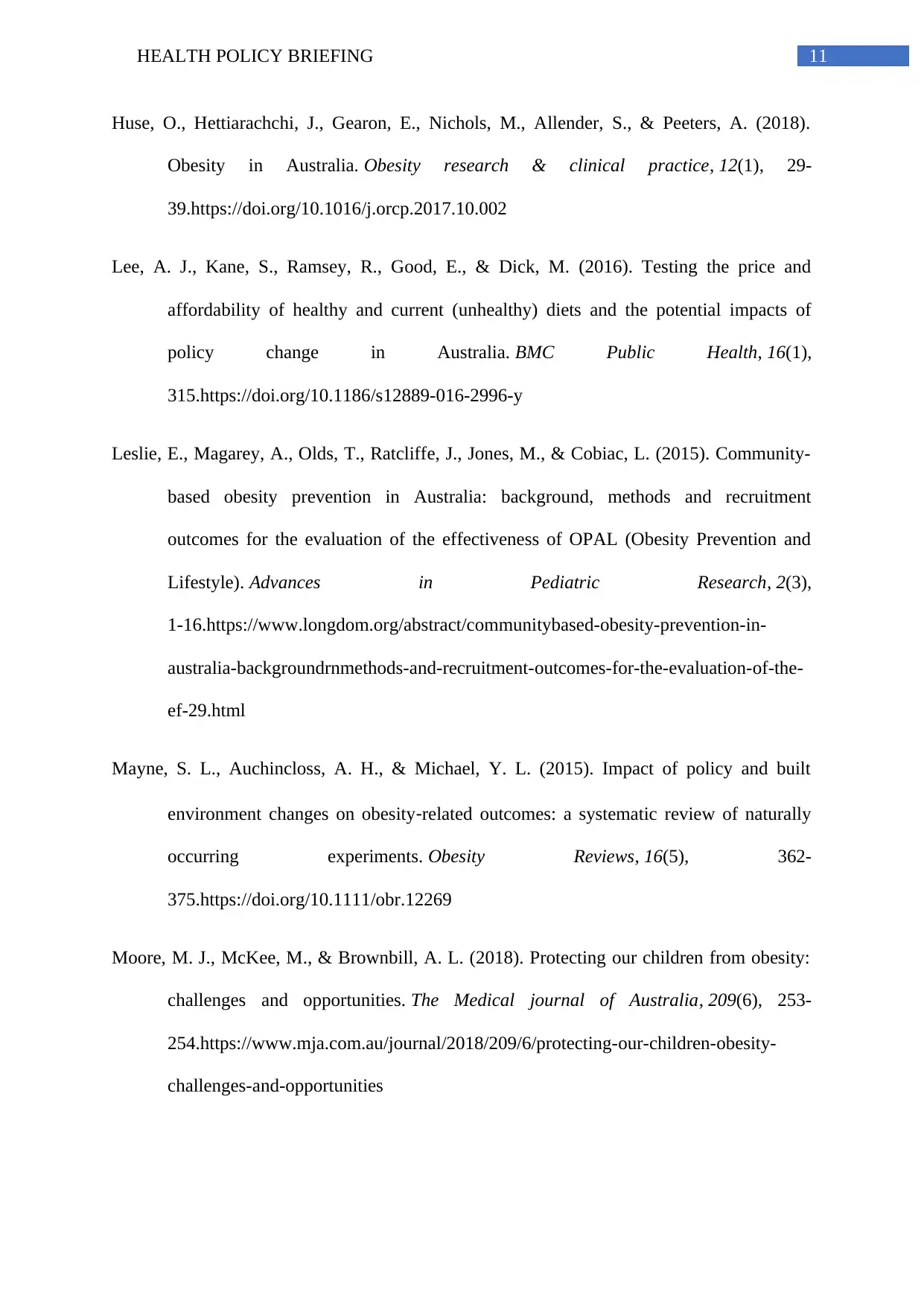
11HEALTH POLICY BRIEFING
Huse, O., Hettiarachchi, J., Gearon, E., Nichols, M., Allender, S., & Peeters, A. (2018).
Obesity in Australia. Obesity research & clinical practice, 12(1), 29-
39.https://doi.org/10.1016/j.orcp.2017.10.002
Lee, A. J., Kane, S., Ramsey, R., Good, E., & Dick, M. (2016). Testing the price and
affordability of healthy and current (unhealthy) diets and the potential impacts of
policy change in Australia. BMC Public Health, 16(1),
315.https://doi.org/10.1186/s12889-016-2996-y
Leslie, E., Magarey, A., Olds, T., Ratcliffe, J., Jones, M., & Cobiac, L. (2015). Community-
based obesity prevention in Australia: background, methods and recruitment
outcomes for the evaluation of the effectiveness of OPAL (Obesity Prevention and
Lifestyle). Advances in Pediatric Research, 2(3),
1-16.https://www.longdom.org/abstract/communitybased-obesity-prevention-in-
australia-backgroundrnmethods-and-recruitment-outcomes-for-the-evaluation-of-the-
ef-29.html
Mayne, S. L., Auchincloss, A. H., & Michael, Y. L. (2015). Impact of policy and built
environment changes on obesity‐related outcomes: a systematic review of naturally
occurring experiments. Obesity Reviews, 16(5), 362-
375.https://doi.org/10.1111/obr.12269
Moore, M. J., McKee, M., & Brownbill, A. L. (2018). Protecting our children from obesity:
challenges and opportunities. The Medical journal of Australia, 209(6), 253-
254.https://www.mja.com.au/journal/2018/209/6/protecting-our-children-obesity-
challenges-and-opportunities
Huse, O., Hettiarachchi, J., Gearon, E., Nichols, M., Allender, S., & Peeters, A. (2018).
Obesity in Australia. Obesity research & clinical practice, 12(1), 29-
39.https://doi.org/10.1016/j.orcp.2017.10.002
Lee, A. J., Kane, S., Ramsey, R., Good, E., & Dick, M. (2016). Testing the price and
affordability of healthy and current (unhealthy) diets and the potential impacts of
policy change in Australia. BMC Public Health, 16(1),
315.https://doi.org/10.1186/s12889-016-2996-y
Leslie, E., Magarey, A., Olds, T., Ratcliffe, J., Jones, M., & Cobiac, L. (2015). Community-
based obesity prevention in Australia: background, methods and recruitment
outcomes for the evaluation of the effectiveness of OPAL (Obesity Prevention and
Lifestyle). Advances in Pediatric Research, 2(3),
1-16.https://www.longdom.org/abstract/communitybased-obesity-prevention-in-
australia-backgroundrnmethods-and-recruitment-outcomes-for-the-evaluation-of-the-
ef-29.html
Mayne, S. L., Auchincloss, A. H., & Michael, Y. L. (2015). Impact of policy and built
environment changes on obesity‐related outcomes: a systematic review of naturally
occurring experiments. Obesity Reviews, 16(5), 362-
375.https://doi.org/10.1111/obr.12269
Moore, M. J., McKee, M., & Brownbill, A. L. (2018). Protecting our children from obesity:
challenges and opportunities. The Medical journal of Australia, 209(6), 253-
254.https://www.mja.com.au/journal/2018/209/6/protecting-our-children-obesity-
challenges-and-opportunities
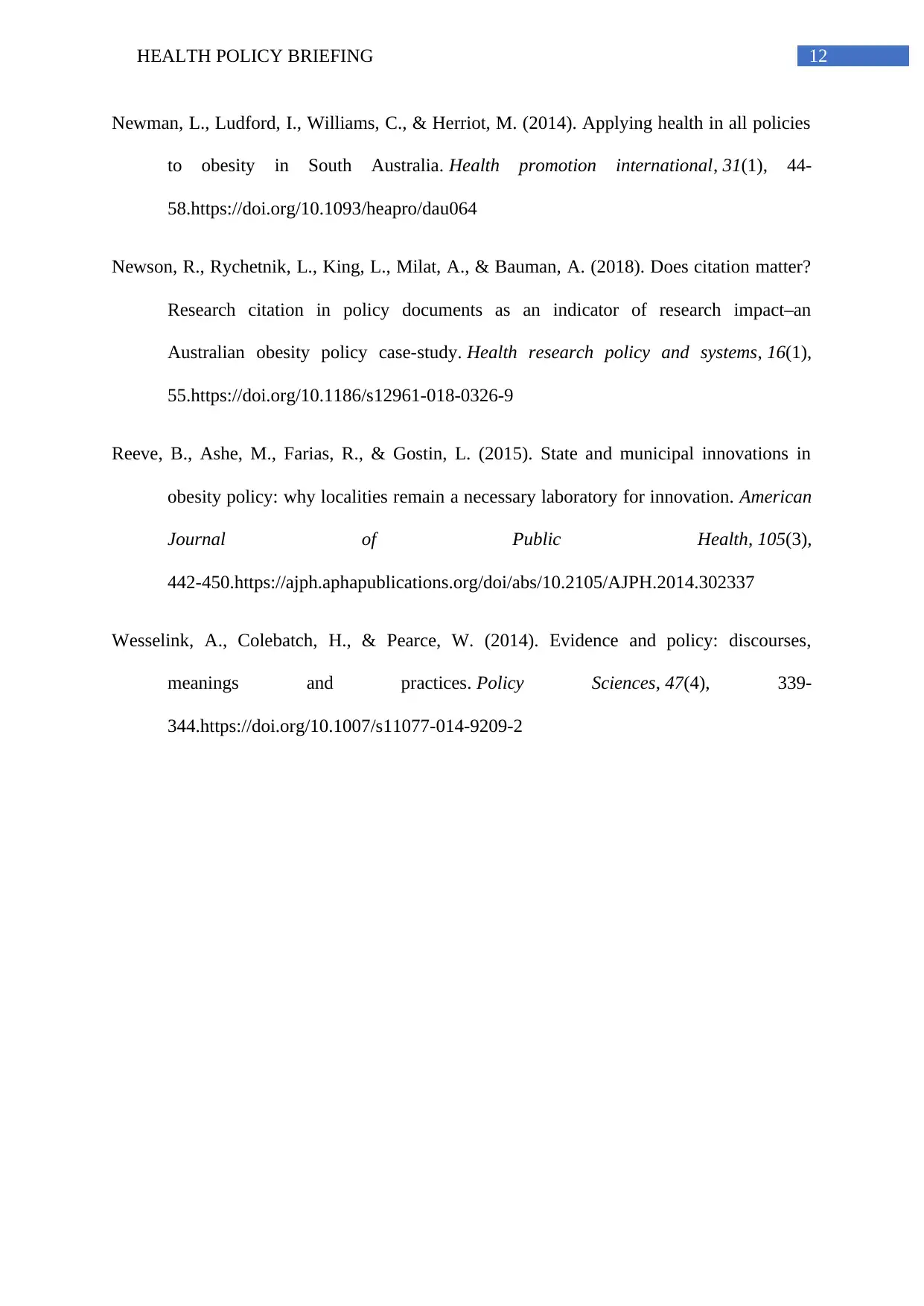
12HEALTH POLICY BRIEFING
Newman, L., Ludford, I., Williams, C., & Herriot, M. (2014). Applying health in all policies
to obesity in South Australia. Health promotion international, 31(1), 44-
58.https://doi.org/10.1093/heapro/dau064
Newson, R., Rychetnik, L., King, L., Milat, A., & Bauman, A. (2018). Does citation matter?
Research citation in policy documents as an indicator of research impact–an
Australian obesity policy case-study. Health research policy and systems, 16(1),
55.https://doi.org/10.1186/s12961-018-0326-9
Reeve, B., Ashe, M., Farias, R., & Gostin, L. (2015). State and municipal innovations in
obesity policy: why localities remain a necessary laboratory for innovation. American
Journal of Public Health, 105(3),
442-450.https://ajph.aphapublications.org/doi/abs/10.2105/AJPH.2014.302337
Wesselink, A., Colebatch, H., & Pearce, W. (2014). Evidence and policy: discourses,
meanings and practices. Policy Sciences, 47(4), 339-
344.https://doi.org/10.1007/s11077-014-9209-2
Newman, L., Ludford, I., Williams, C., & Herriot, M. (2014). Applying health in all policies
to obesity in South Australia. Health promotion international, 31(1), 44-
58.https://doi.org/10.1093/heapro/dau064
Newson, R., Rychetnik, L., King, L., Milat, A., & Bauman, A. (2018). Does citation matter?
Research citation in policy documents as an indicator of research impact–an
Australian obesity policy case-study. Health research policy and systems, 16(1),
55.https://doi.org/10.1186/s12961-018-0326-9
Reeve, B., Ashe, M., Farias, R., & Gostin, L. (2015). State and municipal innovations in
obesity policy: why localities remain a necessary laboratory for innovation. American
Journal of Public Health, 105(3),
442-450.https://ajph.aphapublications.org/doi/abs/10.2105/AJPH.2014.302337
Wesselink, A., Colebatch, H., & Pearce, W. (2014). Evidence and policy: discourses,
meanings and practices. Policy Sciences, 47(4), 339-
344.https://doi.org/10.1007/s11077-014-9209-2
1 out of 13
Related Documents
Your All-in-One AI-Powered Toolkit for Academic Success.
+13062052269
info@desklib.com
Available 24*7 on WhatsApp / Email
![[object Object]](/_next/static/media/star-bottom.7253800d.svg)
Unlock your academic potential
© 2024 | Zucol Services PVT LTD | All rights reserved.




